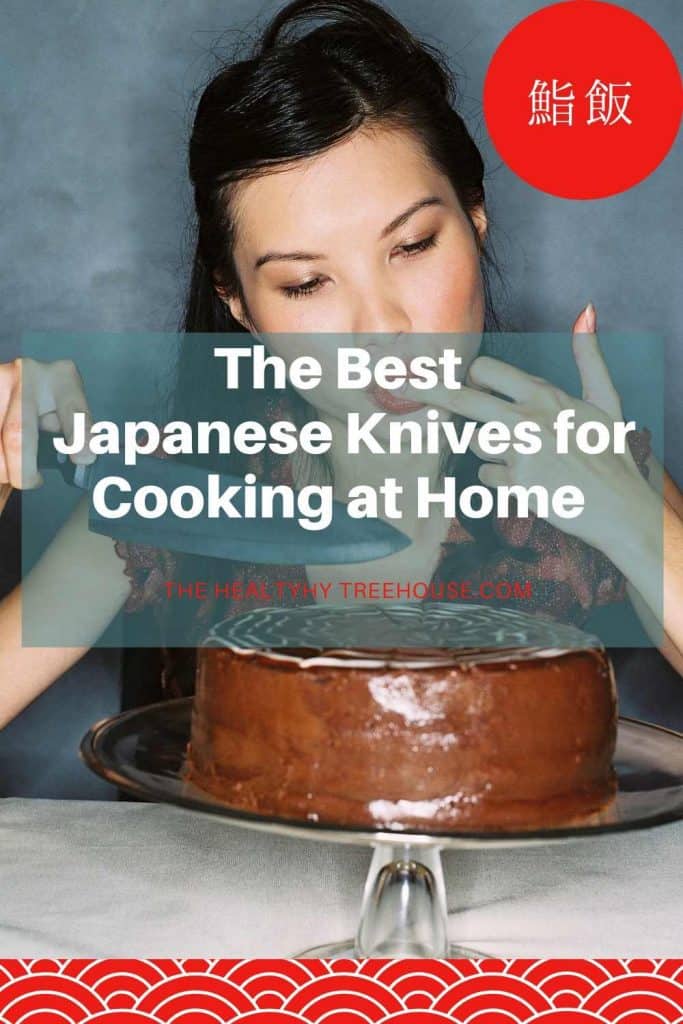The Japanese have been honing their blades for generations, in the most literal sense of the word, and it’s time to get on the bandwagon. It was a serious game changer when we picked up ours.
The best Japanese knife will have a cutting edge and hardness that surpasses most western-style knives.
Our choices for the best Japanese knives are:
- TUO – 7” Cutlery Cleaver Knife – Fiery Phoenix Series — Best Cleaver
- MAD SHARK – 8” Santoku Knife – High Carbon Stainless Steel Knife with Ergonomic Handle — Most Affordable
- Zelite Infinity – 8” Gyuto Knife – Super Stainless Steel Blade — Sharpest Gyuto Knife
- TradaFor – 7” Nakiri (Vegetable) Knife – Stainless Steel High Carbon Pro Chef Knife – Gift Box — Best Vegetable Knife
Why Are Japanese Knives the Best?
The first difference you’ll notice between a traditional Japanese knife and a typical kitchen knife is that the best Japanese knives are usually made from high-carbon steel instead of stainless steel.
Consider these other main factors when choosing your knife:
- Type of steel
- Blade style
- Handle style
- Knife purpose
High-Carbon Steel
All steel is an alloy of iron and carbon, but if the carbon content is more than 0.6 percent, then the steel is classified as high-carbon steel. These blades are long lasting, retain their sharpness when used properly, and are rigid. Unfortunately, the rigidity makes them slightly more brittle and prone to breakage if misused.
Stainless Steel
Because stainless steel is much more resistant to rust, the blade will remain sharp and won’t corrode. You won’t have to worry about rust flakes flavoring your meats and vegetables.
Hammered Steel and Damascus Steel
Hammered steel knives have dents spread across the flat of the blade. This gives the knife a peculiar type of beauty. The dents come from the hammering and forging of the blades.
Hammered steel is typically a high-carbon steel, and the dent pattern gives the blade durability and flexibility. The dents also help prevent most foods from sticking to the knife blade, which can make food preparation much quicker.
Damascus steel, on the other hand, has a mesmerizing wave pattern across the surface. It’s unrivaled in terms of visual appeal. This steel is also high carbon, very hard and durable, and it can have a lasting sharp edge.

Blade Styles
Traditional western-style blades typically have a double bevel. These knives feel more balanced and ambidextrous because the blades look equally sharp on both sides.
Traditional Japanese knives have a single bevel. For a right-handed chef, a single-bevel knife feels much more precise and can seem much sharper.
The choice between single-bevel and double-bevel blades is mostly a personal preference.
Handle Styles
Nearly all modern knives have a square grip to prevent twisting and slipping, as well as finger contours for a stable handhold.
Traditional Japanese knives have a radically different grip, called a Wa handle. These handles are cylindrical and smooth. The handles are also usually made of wood and are lightweight.
Japanese knife handles take some time to get used to. They make the knife feel unbalanced and heavier at the tip and feel much less secure in the grip. Once you’re accustomed to the Japanese handle, however, it should feel more precise and allows for faster knife-handling skills.
Japanese Knife Types and Purposes
Here are some of the most common types of Japanese knives:
- Gyuto: Like a chef’s knife, for chopping vegetables or slicing beef cuts
- Santoku: Flatter knife for fish and vegetables
- Nakiri: Vegetable knife with a square tip for stronger chopping
- Petty: Smaller knife for paring or peeling
- Sujihiki: Long knife for cutting steaks and other cuts of meat
Is It Worth Buying Knives in Japan?
While some might be tempted to travel to Japan to get an authentic set of kitchen knives, it isn’t worth it. Some of the best Japanese knives can be found at your fingertips online.
How Did We Select Our Best Japanese Chef Knives?
Among all of the knives available online, we selected blades based on these qualities:
- Hardness: The harder the material, the better.
- Sharpness: Some knives can blunt easily, so we discounted these.
Top-Rated Japanese Knives- Best Cleaver
TUO - 7” Cutlery Cleaver Knife - Pakkawood Handle - Fiery Phoenix Series
Includes
- 1 knife.
Features
- Blade is made from AUS-10 high-quality steel.
- Polished pakkawood handle.
- 66 layers of steel.
Pros
- Beautiful knife – aesthetically pleasing
- Blade is super strong and holds its edge for a long time
Cons
- No rivets in the tang on the grip
- Handle is more beautiful than practical
The TUO 7” Cleaver Japanese knife is beautiful, featuring a Damascus steel blade and a polished pakkawood handle. Eighty-four percent of customers gave this chef knife a five-star rating after trying it out.
The knife is constructed using many layers of high-carbon steel and stainless steel. This gives it a rust-proof coating, so you won’t have to worry about thoroughly drying the knife after each washing.
The polished pakkawood is exotically beautiful and smooth. Perhaps too smooth, as many users complained about the lack of grip when it gets wet or oily. The handle is also not reinforced by a full-width tang, and in some cases, broke free from the blade.
Michael, in August 2017, has this to say: “The push cut performance of this knife on vegetables is really great.”
Top-Rated Japanese Knife — Most Affordable
MAD SHARK - 8" Santoku Knife - High Carbon Stainless Steel Knife
Includes
- 8-inch knife.
- Finger guard.
- Cleaning cloth.
Features
- Hollow edge means food won’t stick.
- Well-balanced handle for safe cutting.
- Full tang.
- Affordable.
The MAD SHARK Santoku Japanese knife is an excellent and cheap starter knife with some interesting blade features. Eighty-two percent of customers loved it so much that they gave it five stars.
The high-carbon steel blade has a hardness of 56 on the Rockwell Hardness Scale. This should reduce the need to frequently sharpen the blade. The steel also contains enough chromium to be labeled as stainless steel.
The oval-shaped divot pattern along the edge of the blade is designed to prevent suction that keeps food stuck on the sides. This will make your food preparation quick and easy, and it’s safer for your fingers, too.
Unlike other Japanese knives with Wa handles, this one has rivets to hold the grip on tight. The blade actually has a full tang that extends all the way through the handle, so this knife isn’t going to fall apart on you.
The price tag on this knife also makes it extremely attractive, especially for beginner chefs.
Brandi, in November 2018, has this to say: “I have never purchased a brand new knife that was THIS SHARP before!”
Negatives? Some customers complained that the blade loses sharpness quickly.
Top-Rated Japanese Knife — Best Chef’s Gyuto Knife
Zelite Infinity - 8” Gyuto Knife - Super Stainless Steel Blade
Includes
- 1 knife.
- Gift box.
Features
- Made from 67-layer AUS-10 steel.
- Contoured and riveted Western grip.
- Finished with Honbazuke sharpening.
Gyuto knives are the best Japanese chef knives in the world, and the Zelite Infinity – 8” Gyuto Knife – Super Stainless Steel Blade is one of the best premium Japanese knives you can find. It also features the quality AUS-10 high-carbon steel, with a Rockwell hardness of 56. Eighty-five percent of buyers gave this knife a five-star rating when we reviewed it.
Right out of the box, you’ll be amazed by the sharpness of this knife. It’s finished with the traditional Japanese Honbazuke three-stage sharpening to give it a keen and lasting cutting edge. The blade edge is sharpened to 12 degrees, which is one of the narrowest, sharpest blades in the industry.
If you’re willing to spend the extra money on a versatile Japanese knife that starts sharp and stays sharp, you can’t go wrong with the Zelite Infinity Gyuto.
Matthew, in September 2016, has this to say: “I’m not kidding, you could shave with it.”
Negatives? Some customers complained about its price.
Top-Rated Japanese Knife — Best Vegetable Nakiri Knife
TradaFor – 7” Nakiri (Vegetable) Knife – Stainless Steel High Carbon Pro Chef Knife
Includes
- 1 knife.
- Gift box.
Features
- 1.4116 German high-carbon stainless steel.
- Polished pakkawood handle.
- Single bevel.
The TradaFor – 7” Nakiri (Vegetable) Knife – Stainless Steel High Carbon Pro Chef Knife is a great choice for chopping vegetables. Also, its German steel combines the rust-free qualities of stainless steel and the hardness of high carbon steel. When we checked, 73 percent of customers gave this product a five-star rating.
As a single bevel blade, you can expect it to be sharp. However, this knife is only made for right-handed chefs, so lefties might find it awkward to use.
The pakkawood handle is beautiful, but this knife lacks a full-sized tang to hold it in place.
Andrew, in August 2018, has this to say: “I trust that it will bring the flavor and beauty of the vegetables that I bought from the local farmers market.”
Negatives? Some customers complained about its price.
Alternative Knives
Consider these Japanese knives if the above aren’t to your liking:
- XINZUO – 5 Piece Kitchen Knife Set – Damascus Steel High Carbon Steel – Ya Series
- Emojoy – 16-Piece Knife Set with Santoku Knife – Stainless Steel.
Conclusion
We’re sure you’ll love using any of these featured knives, but our top pick is the TUO – 7” Cutlery Cleaver Knife – Ergonomic Pakkawood Handle – Fiery Phoenix Series.
It combines the highest quality construction and materials at an affordable price. This knife stays sharp, lasts long, and looks beautiful.
Whether cutting thick slabs of meat or chopping vegetables, this versatile Japanese knife will get the job done safely and quickly.






